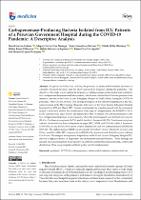| dc.contributor.author | García-Cedrón, David | |
| dc.contributor.author | De La Cruz Noriega, Magaly | |
| dc.contributor.author | Cabanillas-Chirinos, Luis | |
| dc.contributor.author | Milly Otiniano, Nélida | |
| dc.contributor.author | Rojas-Villacorta, Walter | |
| dc.contributor.author | Salvatierra-Espinola, Waldo | |
| dc.contributor.author | Diaz Del Aguila, Karen | |
| dc.date.accessioned | 2023-12-21T15:16:07Z | |
| dc.date.available | 2023-12-21T15:16:07Z | |
| dc.date.issued | 2023 | |
| dc.identifier.uri | https://hdl.handle.net/20.500.13067/2907 | |
| dc.description.abstract | Background and Objectives: In Peru, the presence of antimicrobial-resistant bacteria is a constant concern in hospitals and has likely increased in frequency during the pandemic. The objective of the study was to analyze the frequency of carbapenemase-producing bacteria resistant to two carbapenems (Imipenem and Meropenem), which were isolated from Peruvian patients in the intensive care unit of the Victor Lazarte Echegaray Hospital in Trujillo (Peru) during the COVID-19 pandemic. Materials and Methods: The biological samples of the patients hospitalized in the ICU were processed in the Microbiology Diagnostic Laboratory of the Víctor Lazarte Echegaray Hospital between May 2021 and March 2022. Antimicrobial sensitivity was determined with the automated system AutoScan-4, and for the identification of the type of carbapenemase, the RESISIT-3 O.K.N K-SET cassettes were used. Results: The results show that 76 cultures (76/129) had resistance to the two carbapenems (imipenem or meropenem), where the most frequent were Klebsiella pneuomoniae (31.6%), Pseudomonas aeruginosa (26.3%), and Acinetobacter baumannii (14.5%). Pseudomonas aeruginosa cultures showed at least three carbapenemase types (KPC, NDM, and OXA-48), while A. baumannii, Escherichia coli, and Burkholderia cepacia complex presented at least two carbapenemases (NDM and OXA-48). The carbapenemase NDM was detected in Enterobacter cloacae, Morganella morganii, and Proteus mirabilis, while KPC was present in all Klebsiella pneumoniae and Klebsiella oxytoca cultures. Conclusions: The samples from patients hospitalized in the Victor Lazarte Echegaray Hospital ICU showed a high prevalence of imipenem- and meropenem-resistant bacteria. These findings are relevant and concerning from the perspective of antibiotic-resistant bacteria monitoring, control, and disinfection. Thus, an appropriate antibiotic policy must be implemented. | es_PE |
| dc.format | application/pdf | es_PE |
| dc.language.iso | eng | es_PE |
| dc.publisher | MDPI | es_PE |
| dc.rights | info:eu-repo/semantics/openAccess | es_PE |
| dc.rights.uri | https://creativecommons.org/licenses/by/4.0/ | es_PE |
| dc.subject | Pandemic | es_PE |
| dc.subject | COVID-19 | es_PE |
| dc.subject | Carbapenemases | es_PE |
| dc.subject | Antimicrobial resistance | es_PE |
| dc.subject | Antimicrobial use | es_PE |
| dc.title | Carbapenemase-Producing Bacteria Isolated from ICU Patients of a Peruvian Government Hospital during the COVID-19 Pandemic: A Descriptive Analysis | es_PE |
| dc.type | info:eu-repo/semantics/article | es_PE |
| dc.identifier.journal | Medicina | es_PE |
| dc.identifier.doi | https://doi.org/10.3390/medicina59101763 | |
| dc.subject.ocde | https://purl.org/pe-repo/ocde/ford#2.07.00 | es_PE |
| dc.source.volume | 59 | es_PE |
| dc.source.issue | 10 | es_PE |
| dc.source.beginpage | 1 | es_PE |
| dc.source.endpage | 11 | es_PE |


